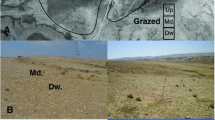Summary
A study was begun in 1976 to measure succession patterns following soil disturbance within a sagebrush community in northwestern Colorado. The principal hypothesis was that type of disturbance affects the direction of succession, resulting in different plant communities over time. Successional dynamics were studied through 1988. Four types of soil disturbance resulted in 3 early seral communities: one dominated by grasses, one by annuals, and one intermediate. The annual-dominated communities were opportunistic on these sites, lasting 3–5 years and not determining the direction in which succession proceeded following their replacement. Twelve years after disturbance, 3 communities (one grass-dominated, one shrub-dominated, and one intermediate) occupied the site, the characteristics of which were functions of type of initial soil disturbance. For the period of time covered by this study (12 years), degree of disturbance was found to affect the direction of succession, resulting in different plant communities over time. There were, however, successional characteristics toward the end of the study that suggest that over a longer time period, succession might progress to a single community regardless of type of disturbance.
Similar content being viewed by others
References
Allen EB, Knight DH (1984) The effects of introduced annuals on secondary succession in sagebrush-grassland, Wyoming. Southwest Nat 29:407–421
Biondini ME, Bonham CD, Redente EF (1985) Secondary successional patterns in a sagebrush (Artemisia tridentata) community as they relate to soil disturbance and soil biological activity. Vegetatio 60:25–36
Boerner RE (1985) Alternate pathways of succession on the Lake Eric Islands. Vegetatio 63:35–44
Carpenter AT, Moore JC, Redente EF, Stark JM (1990) Plant community dynamics in relation to nutrient addition following a major disturbance. Plant Soil (in press)
Drury WH, Nisbet ICT (1973) Succession. Arnold Arb 54:331–368
Glenn-Lewin DC (1980) The individualistic nature of plant community development. Vegetatio 43:141–146
Gray FA (1961) An Introduction to Linear Statistical Models. Vol. 1. McGraw-Hill, New York. p 463
Gurevitch J, Chester ST Jr (1986) Analysis of repeated measured experiments. Ecology 67:251–255
Hatton TJ, West NE (1987) Early seral trends in plant community diversity on a recontoured surface mine. Vegetatio 73:21–29
Horn HS (1981) Succession. In: May RH (ed) Theoretical Ecology. 2nd Edition. Blackwell, Oxford, England
Humphrey LD (1984) Patterns and mechanisms of plant succession after fire on Artemisia-grass sites in southeastern Idaho. Vegetatio 57:91–101
Inouye RS, Tilman D (1988) Convergence and divergence of oldfield communities along experimental nitrogen gradients. Ecology 69:995–1004
John PWM (1971) Statistical Design and Analysis of Experiments. MacMillian, New York, p 356
Lachenbruch PA (1979) A study of the variability of some successional and climax plant assemblage-types using multiple discriminant analysis. J Ecol 67:255–271
McLendon T, Dahl BE (1983) A method for mapping vegetation utilizing multivariate statistical techniques. J Range Manage 36:457–462
Noble IR, Slayter RO (1980) The use of vital attributes to predict successional changes in plant communities subject to recurrent disturbances. Vegetatio 43:5–21
Overall JE, Klett CJ (1972) Applied Multivariate Analysis. McGraw-Hill. New York, p 500
Peet RK, Christensen NL (1980) Succession: a population process. Vegetatio 43:131–140
Peterman M (1980) Influence of ecosystem structure and perturbation history on recovery processes. In: Cairns J, Jr, (ed) The Recovery Process in Damaged Ecosystems. An Arbor Science, Ann Arbor, Michigan pp 125–139
Pickett STA, Thompson JN (1978) Patch dynamics and the design of nature reserves. Biol Conserv 13:27–37
Pineda FC, Nicolas JP, Pon A, Galiano EF (1981) Ecological succession in oligotrophic pastures of central Spain. Vegetatio 44:165–176
Redente EF, Cook CW, Stark JM, Simmons CL (eds) (1985) Semiarid Ecosystem Development as a Function of Resource Processing and Allocation. Progress Report for DOE (DE-A502-T5EV04018). Range Sci. Dept., Colorado State Univ., Fort Collins, p 99
Stark JM (1983) Soil plant diversity relationships on disturbed sites in the Piceance Basin. M.S. Thesis. Colorado State Univ., Fort Collins
Stewart-Oaten A, Murdoch WW (1986) Environmental impact assessment: “pseudoreplication” in time? Ecology 67:929–940
Stroup WM, Stubbendieck J (1983) Multivariate statistical methods to determine changes in botanical composition. J Range Manage 36:208–212
Van Hulst R (1978) On the dynamics of vegetation: patterns of environmental and vegetational change. Vegetatio 38:65–75
Van Hulst R (1979) On the dynamics of vegetation: succession in model communities. Vegetatio 39:85–96
Van Hulst R (1980) Vegetation dynamics or ecosystem dynamics: dynamic sufficiency in succession theory. Vegetatio 43:147–151
Vasek FC (1980) Early-successional stages in Mojave Desert scrub vegetation. Israel J Bot 28:133–148
Author information
Authors and Affiliations
Rights and permissions
About this article
Cite this article
McLendon, T., Redente, E.F. Succession patterns following soil disturbance in a sagebrush steppe community. Oecologia 85, 293–300 (1990). https://doi.org/10.1007/BF00319415
Received:
Accepted:
Issue Date:
DOI: https://doi.org/10.1007/BF00319415




